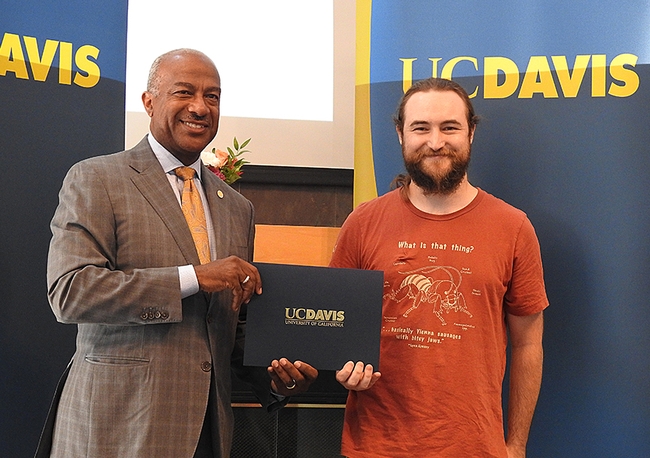- Author: Kathy Keatley Garvey

Emily Meineke, assistant professor of urban landscape entomology, UC Davis Department of Entomology and Nematology, and coordinator of the department's seminars for the 2022-23 academic year, announced that all 11 seminars will take place both in-person and virtually at 4:10 p.m. on Wednesdays. in Room 122 of Briggs Hall except for the Nov. 9th and Dec. 7th seminars, which will be virtual only.
First in line is assistant professor Nicholas "Nick" Miller of the Department of Biology, Illinois Institute of Technology, Chicago, who will present his seminar on "Adaptation in the Cornfield, Research in the Classroom." The Zoom link: https://ucdavis.zoom.us/j/
Host is molecular geneticist and physiologist Joanna Chiu, professor and vice chair of the Department of Entomology and Nematology.

"Our interest in Diabrotica biology and evolution has lead naturally to an interest in Diabrotica genomics," Miller related. "Sequencing arthropod genomes is becoming relatively easy but analyzing and understanding those genomes remains hard and labor intensive. The flood of arthropod and other non-model genome sequences represents an opportunity for undergraduates to access research experiences that would otherwise be unavailable."
Research in the Miller lab focuses on the population genetics and evolution of herbivorous insects. "We mostly study species that are pests of agriculture," he says on his website. "Key areas of interest include: adaptation by insect pests to the technologies intended to control them, including genetically-modified crops and pesticides; the interactions of specialist and generalist herbivores to plant defenses; dispersal and movement of insects and the genes they carry."
The other speakers:
Wednesday, Sept. 28
Nissa Coit, master's degree candidate studying honey bees
Elina Niño Bee Laboratory, UC Davis Department of Entomology and Nematology
Title: "Effects of Ethyl Oleate Pheromone on Honey Bee (Apis mellifera) Overwintering Physiology” (Exit seminar)
Wednesday, Oct. 5
Olivia Winokur, doctoral candidate studying how the environment and mosquito behavior affect transmission dynamics of mosquito-borne viruses
Christopher Barker lab, Department of Pathology, Microbiology and Immunology, School of Veterinary Medicine, UC Davis
Topic: Exit Seminar (title pending)
Wednesday, Oct. 12
Julian Dupuis, assistant professor, Department of Entomology, University of Kentucky
Title: “Developing Genomics-Based Molecular Diagnostic Tools for Recurrently Invading Tephritid Pests"
Host: Joanna Chiu, professor and vice chair of the Department of Entomology and Nematology
Wednesday, Oct. 19
Filipa Rijo-Ferreira, assistant professor, Department of Molecular and Cell Biology, UC Berkeley
Title: "Circadian Rhythms in Parasitic Diseases"
Host: Joanna Chiu, professor and vice chair of the Department of Entomology and Nematology
Wednesday, Oct. 26
Yao Cai, doctoral candidate
Joanna Chiu laboratory, UC Davis Department of Entomology and Nematology
Title: Exit Seminar: "How Do Flies Tell the Time of Day?"
Host: Joanna Chiu, professor and vice chair of the Department of Entomology and Nematology
Wednesday, Nov. 2
Wanhe Li, assistant professor, Department of Biology, Texas A&M
Title: “How Time Flies During Lock-down?--Mechanisms Underlying Chronic Social Isolation-Induced Sleep Loss in Drosophila”
Host: Joanna Chiu, professor and vice chair of the Department of Entomology and Nematology
Wednesday, Nov. 9 (virtual only)
Xoaquín Moreira, Biological Mission of Galicia (CSIC)
Title: “Insularity Effects on Plant-Herbivore Interactions: Searching for Biotic and Abiotic Explanatory Variables to Promote Insular Biodiversity Conservation”
Host: Richard "Rick" Karban, UC Davis distinguished professor of entomology
Wednesday, Nov. 16
Cynthia Gleason, assistant professor, Department of Plant Pathology, Washington State University
Title: “How Do We Help Potato Growers Combat the Root-Knot Nematode Meloidogyne chitwoodi?”
Host: Shahid Siddique, assistant professor, UC Davis Department of Entomology and Nematology
Wednesday, Nov. 30 (postponed as of Nov. 28; to be presented at a later date)
Quinn McFrederick, assistant professor Department of Entomology, UC Riverside
Title: To be announced
He specializes in insect-symbiont interactions, particularly the study of wild bees.
Host: Rachel Vannette, associate professor, UC Davis Department of Entomology and Nematology
Wednesday, Dec. 7 (virtual only)
Mônica Ulyssea, Universidade de São Paulo Museu de Zoologia
Topic: Ants (title pending)
Expertise in myrmecology, taxonomy, phylogeny, systematics, curatorial practices, and science dissemination
Host: Jill Oberski, doctoral candidate, Phil Ward laboratory, UC Davis Department of Entomology and Nematology
For further information on the seminars or technical difficulties with Zoom, contact the coordinator at ekmeineke@ucdavis.edu.

- Author: Kathy Keatley Garvey
To be a fly on Friday, what a day!
Entomologists who came up with "Friday Fly Day" are having a lot of fun posting images on social media of flies on Friday.
If you access WikiHow, "What to Do on a Friday Night," you'll find all kinds of suggestions. For instance:
- Watch a movie (that's do-able)
- Challenge friends to a game night (does anybody play games any more?)
- Treat yourself to a spa at home (a spa?)
- Give yourself a makeover (a what?)
- Cook a nice meal (how nice is nice?)
- Treat yourself to cocktail (some of us prefer coffee or water)
- Read a book or a magazine (did that, already)
- Start a new hobby (who has the time? Other hobbies are failing)
- Pamper your pet (he's already pampered; he has his own Facebook page, Vito and His Friends)
- Throw a karaoke or dance party (the neighbors would not like that)
- Work on an artistic or crafty project (some of us are crafty but not artistic)
- Start a bonfire (not in California!)
- Do something physically active (stationary bikes are good)
- and on and on and on....
Nowhere, but nowhere, does it say to take an image of a fly on Friday.
It doesn't have to be a fly on a wall. It can be a fly on a flower. But it has to be a fly on a Friday.
This one is a syrphid fly, aka flower fly or hover fly (and often mistaken for a honey bee) foraging on a blanket flower, or Gaillardia.
Gaillardia, a genus in the sunflower family, Asteraceae, is named for an 18th century French magistrate/botanist, Maître Gaillard de Charentonneau.
Maître Gaillard de Charentonneau, no doubt, never observed Friday Fly Day but being a botanist, he probably loved pollinators.
Cheers to a syrphid fly on "his" flower. (Well, it is a pollinator)
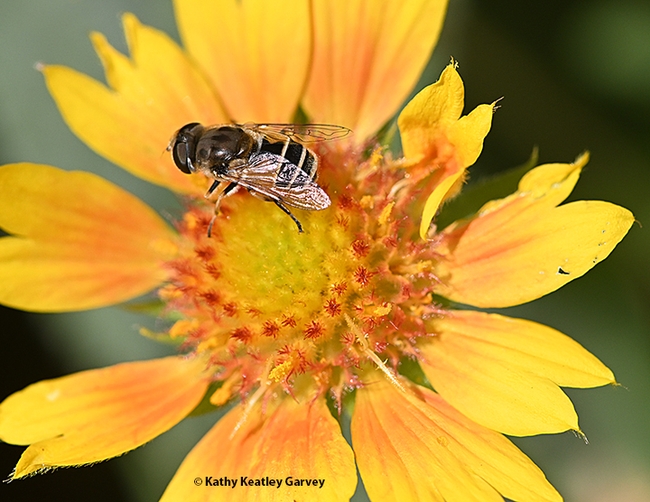
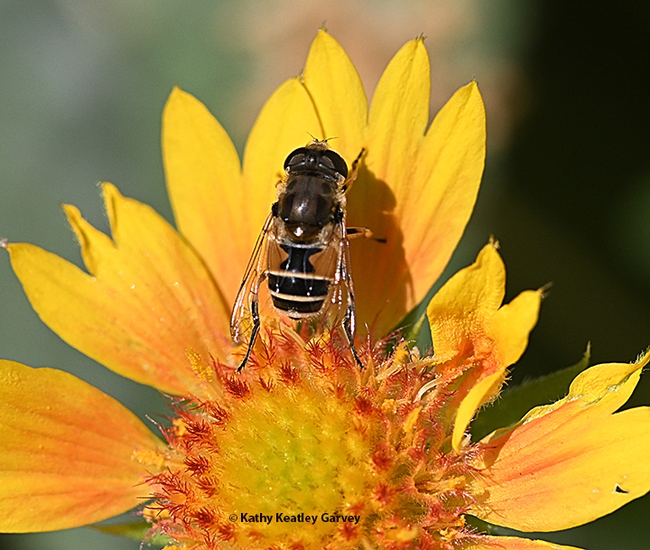
All year long, we've been waiting for those majestic monarchs to visit our pollinator garden in Vacaville, as they have in the past 10 years or so. One year (2020), they deposited more than 300 eggs on our milkweed.
But this year?
Zero. Zilch. Nada.
Where are you?
Dawn. Noon. Dusk.
Where are you?
Nothing has fluttered in and out except the Western tiger swallowtails, Gulf Fritillaries, fiery and common-checkered skippers, cabbage whites, buckeyes, mourning cloaks, and gray hairstreaks.
The milkweed grew, blossomed and went to seed. Ditto the Mexican sunflowers (Tithonia rotundifola). But the patch of Mexican petunia (Ruellia brittoniana) is thriving. The plant is a plucky perennial with purple, petunia-like flowers.
Purple, the color of royalty...a place where a monarch can reign supreme.
And that's exactly what happened today in the petunia patch at 3 p.m. A monarch fluttered in and sipped a little nectar. I almost missed it, as I was observing the Gulf Fritillary activity around the passionflower vine--the males chasing the females, the females laying eggs on the tendrils and leaves, and caterpillars munching the leaves.
The monarch didn't stay long, and I was too far way to move closer, but the Nikon Z-7 with its 105mm macro lens and its 45.7 megapixels, let me know that it was, indeed, one of those majestic monarchs we've been missing.
Hallelujah!
Washington State University entomologist and monarch researcher David James was right. On Aug. 31, he said I'd be seeing monarchs in a few weeks as they're leaving the Pacific Northwest (PNW) on their way to their overwintering sites along the California coast. (See Sept. 2 Bug Squad blog)
"The numbers we are seeing in the PNW this summer are consistent with numbers I've seen in summers past when theoverwintering population was approximately 250,000 as it was last winter," he related Aug. 31. "Last summer (2021) I verified approximately 60 Monarch sightings in the PNW. This summer, I have had approximately 500 verified reports. So, I think we have seen an 8-10 fold increase in Monarch numbers this summer in the PNW. The majority have been in Oregon, followed by Idaho, Washington and British Columbia. There are also positive reports of good numbers of Monarchs in Utah, Nevada and eastern California."
To track migratory monarchs, citizen scientists in the David James' research program affix a tag on the discal cell (underside of the hind wing). (The tag does not interfere with its flight.) This year James handed out 2000 tags to citizen scientists in southern Oregon.
Now, maybe we'll see another tagged traveler like the one we photographed in 2016. The scenario: One of his citizen scientists, Steve Anderson of Ashland, Ore., tagged a male monarch on Aug. 28, 2016 that stopped for nectar in our Vacaville pollinator garden on Sept. 5, 2016. The tag read “Monarch@wsu.edu A6093." It hung around for five hours. (See Bug Squad blog and WSU news story)
"So, assuming it didn't travel much on the day you saw it, it flew 285 miles in 7 days or about 40.7 miles per day," James told us back in 2016. "Pretty amazing. So, I doubt he broke his journey for much more than the five hours you watched him--he could be 100 miles further south by now."
Meanwhile, watch for monarchs! What to do if you see a WSU-tagged monarch? Photograph it, if you can, and contact David James at david_james@wsu.edu or the PNW Facebook page. Also, report any Monarch sightings to iNaturalist and Journey North.
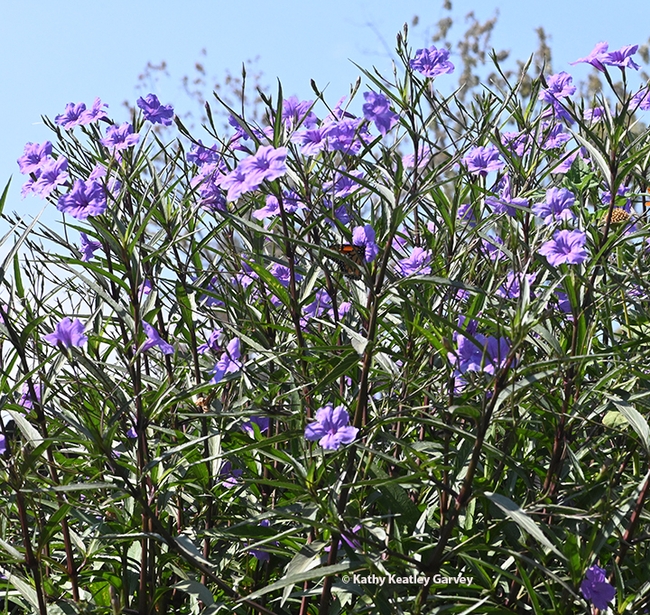
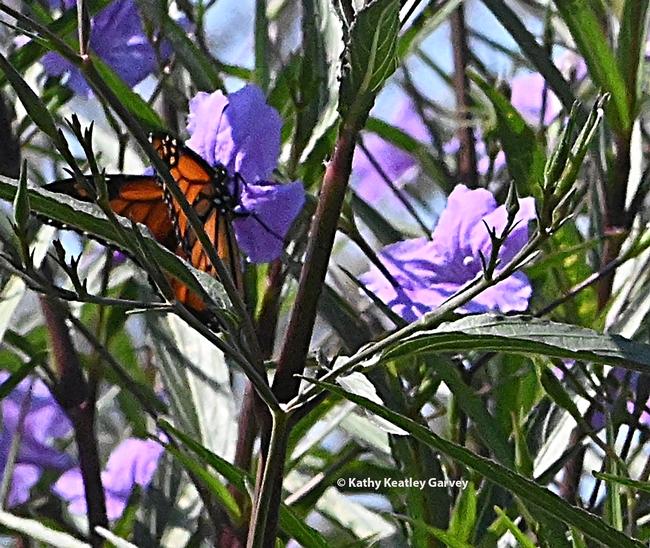
- Author: Kathy Keatley Garvey
It's almost the end of the season for the European wool carder bee, Anthidium manicatum.
A few still hang around the foxgloves, the catmint and the African blue basil in our pollinator garden. They really stand out when they're visiting the hot pink foxgloves (by the way, all parts are poisonous except for the roots), but they're difficult to see when they line up with the African blue basil and the catmint.
Natives of Europe, they were named "carder bees" because the females collect or "card" plant hairs for their nests. The bees, about the size of honey bees, are mostly black and yellow. The females range in body length from 11 to 13 millimeters, while the males are 14 to 17 mm. The males are very territorial as they protect their turf and bodyslam other insects.
These colorful bees were first detected in the United States (New York) in 1963, and first recorded in California (Sunnyvale) in 2007. By 2008, they were well established in the Central Valley, according to Lynn Kimsey, director of the Bohart Museum of Entomology and a UC Davis distinguished professor of entomology. We saw our first one in Vacaville in the spring of 2010.
The bee, according to research entomologist Tom Zavortink of the Bohart Museum of Entomology at UC Davis, was accidentally introduced into New York state. It was not purposefully introduced to pollinate alfalfa, as some reports allege, he said.
Writing in a 2008 edition of the Pan-Pacific Entomologist, Zavortink and fellow entomologist Sandra Shanks, now of Port Townsend, Wash., pointed out that several papers “have documented its spread from neighboring areas in the northeastern United States and southern Canada” and that the species has since crossed the country. It was confirmed in Colorado in 2005, Missouri in 2006, and Maine, Michigan, Maryland and California (Sunnyvale) in 2007, the entomologists wrote. Records show it was first collected in Davis on July 26, 2007.
Its plant preferences include lamb's ear (Stachys byzantine, in the mint family Lamiaceae), a perennial grown for its fuzzy, silvery gray-green foliage. It's also been collected in the figwort/snapdragon family (Scrophulariacae) and the pea and bean family (Fabaceae), according to the Zavortink-Shanks research.
In our yard, they're partial to the foxgloves (shaded) and catmint (full sun). They don't seem to like the lamb's ear (full sun).
They also don't like my camera. The slightest movement, and off they go.
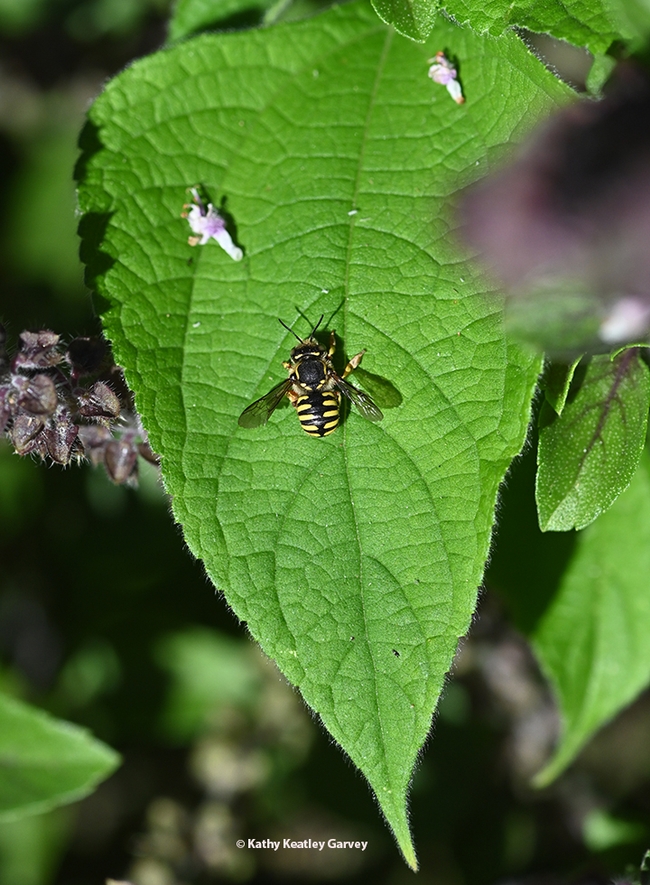
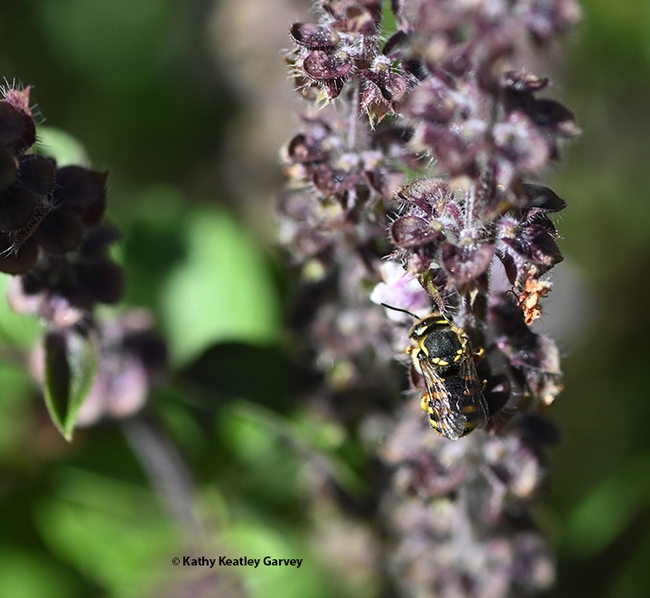
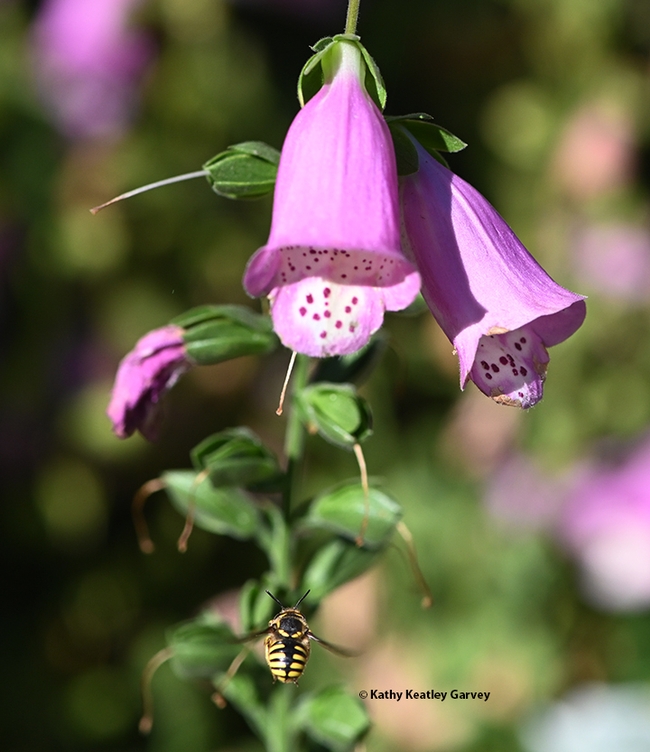
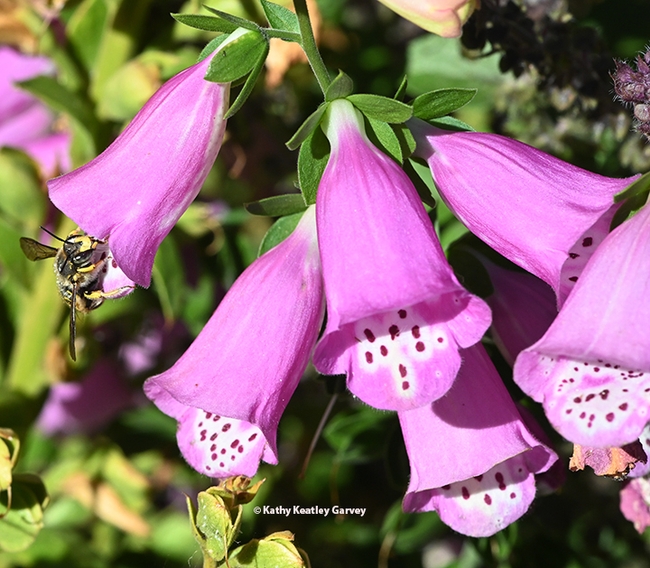
- Author: Kathy Keatley Garvey
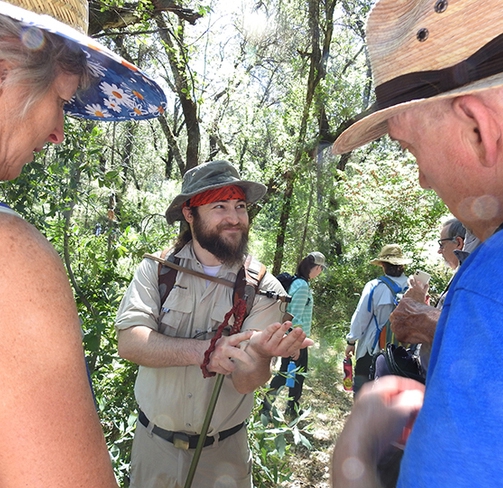
So when the 2018 Paradise fire, known as “The Camp Fire,” destroyed his home, all his possessions and his hometown, his associates stepped forward with donations, including Bohart Museum t-shirts to replace those that he lost in the fire.
The Camp Fire was the deadliest and most destructive wildfire in California's history, and the most expensive natural disaster in the world in 2018 in terms of insured losses. Named after Camp Creek Road, its place of origin, the fire started on Thursday, November 8, 2018, in Northern California's Butte County...The Camp Fire caused at least 85 civilian fatalities, with one person still missing as of August 2, 2019, and injured 12 civilians and five firefighters. It covered an area of 153,336 acres (620.5 km; 239.6 sq mi), and destroyed more than 18,000 structures, with most of the destruction occurring within the first four hours. The towns of Paradise and Concow were almost completely destroyed, each losing about 95% of their structures. The towns of Magalia and Butte Creek Canyon were also largely destroyed. By January 2019, the total damage was estimated at $16.5 billion; one-quarter of the damage, $4 billion, was not insured. The Camp Fire also cost over $150 million in fire suppression costs, bringing the total cost of the fire to $16.65 billion.--Wikipedia.
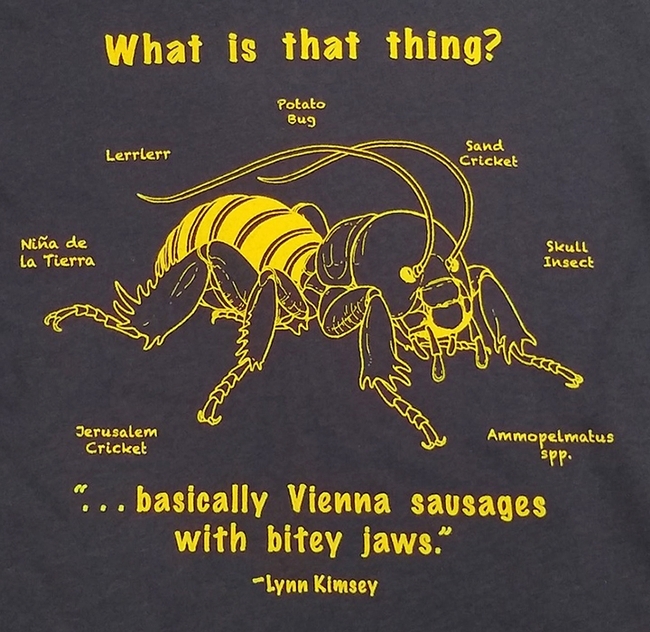
At the ceremony, Dyer receives the honorable mention award, or second-place honors, in the highly competitive service category for providing exemplary services to students, staff, faculty and/or the general campus; making notable contributions to the department and/or campus; for creating and maintaining high morale, and for embodying the principles of community.
Today Dyer credits his “love of science” with helping him overcome life's hardships. “And now in return, he inspires others to love science,” wrote his three nominators Professor Kimsey; Tabatha Yang, education and outreach coordinator; and Kathy Keatley Garvey, communications specialist, UC Davis Department of Entomology and Nematology, who said he "epitomizes the excellence of our UC Davis workforce."
Kimsey described him as “bright, gifted and personable. It doesn't matter what needs to be done in the museum, curation, insect identification, live colony care, computer or software issues, and working with student volunteers, he takes care of it. It is so rare to find someone who can do some of these tasks so well, much less all of them like he can.”
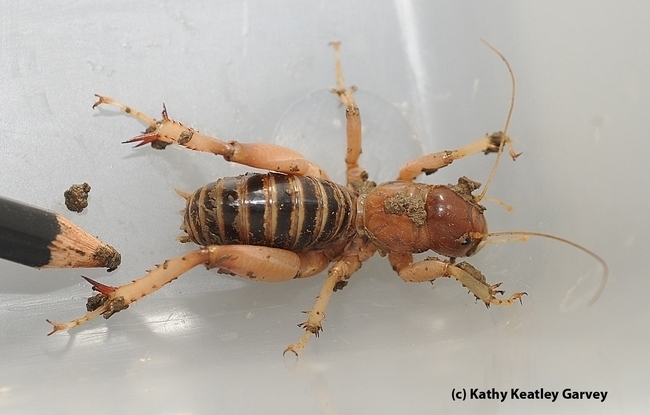
“(Brennen) is what I would generally characterize as a servant leader, defined by a philosophy and practice that aims to enrich the lives of the people," wrote another professor. "He works to build a better organization, and create a more caring environment for everyone. He is an exceptionally hard worker who is always available to assist students, staff, volunteers alike.”
An alumnus pointed out: “(Brennen) is incredible. He is intelligent, meticulous and proactive, and goes above and beyond to assist peers and colleagues. For example, when I was finishing my PhD thesis, I needed photos of insect specimens to add to my last chapter, but I had neither the time nor the skills to utilize our modern microscope to photograph specimens. He generously offered to help, and did so perfectly and quickly. If he hadn't been so reliable and proactive, I wouldn't have been able to finish my PhD in time.”
Other comments from faculty and colleagues:
- “Frankly, we do not know what we would do without him. He is that exemplary. He is always kind, courteous, respectful, reliable, flexible, and eager to help with any project. When you ask for a favor or task from him, you can count on it being done promptly and correctly.”
- “(Brennen) steps up to difficult tasks, such as taking the lead in a landmark, three-year, federally funded project of surveying and databasing insects from three counties in the Sacramento River Delta (to date, 700 species, including 30 new species). He does it all, from organizing collections, coordinating field trips, and training interns, to helping graduate students, faculty and peers with equipment, including the GIGAmacro system and freeze freeze dryer; and assisting them with their projects and publications, such as imaging holotypes and photographing specimens for their publications. With BioQuip closed and supplies scarce, he even designs collecting equipment!”
- “He also serves as the unofficial IT specialist. (Brennen), who learned to dismantle and resassemble computers as a child, troubleshoots the office computers and printers, and assists with the website.
- “He volunteers to drive hundreds of miles to bring back collections, donations or other materials. He eagerly supports UC Davis Picnic Day, (Bohart) open houses, and UC Davis Biodiversity Museum Day. He engages with visitors, showing them displays, answering their questions, and encouraging them to ask more!”
- “(Brennen) strongly supports diversity, equity and inclusion. When a colleague's developmentally disabled aunt arrived for a tour, he noticed her limitless enthusiasm and curiosity for insects, so he headed to the Arboretum to bring back a male Valley carpenter bee (a blond, green-eyed bee known as a ‘teddy bear bee') and let the aunt hold it (note that ‘boy bees don't sting') before releasing it. Her joy, glee and excitement were as unforgettable as (Brennen's) kindness, thoughtfulness and generosity.”
- “(Brennen) has been an anchor to the museum, especially these last COVID years. We are a small team who tries to do big things. (Brennen) is the glue that holds everything together and gets the job done. He supports all aspects of the (workplace) from research to outreach and education. He is tireless and very deserving of recognition. He is not someone who likes to step into the limelight, but is definitely behind the scenes making everything happen smoothly. He is also just a caring and kind co-worker and sensitive to inclusivity and equity.”
Dyer said he is humbled and honored to be singled out for the award.
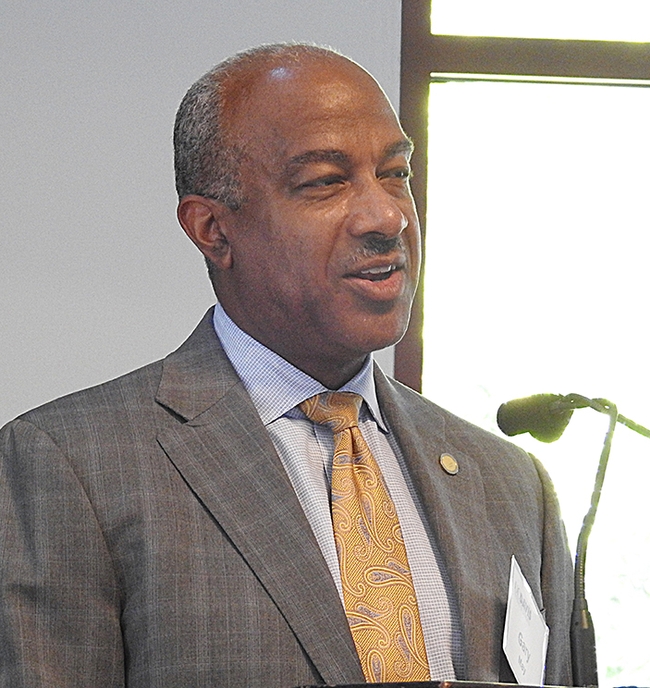
"I could go on," the chancellor continued, "but the fact of the matter is that we are doing great work at UC Davis, and each of you are a part of this effort. I know how important your expertise, experience and institutional memory are to advancing the university's success. It's sometimes difficult to appreciate how our individual contributions make a difference in the 'big picture.' But every day, the work of staff are critical to our university projects, our operations and our campus environment."
Chancellor May pointed out: "These behind-the-scene efforts are what keep UC Davis humming and in tune with our mission of excellence in teaching, research and public service. They are a big part of what your university and Staff Assembly recognizes and thanks you for today. The individuals and teams we honor this afternoon have gone 'above and beyond' all expectations to make UC Davis a more enjoyable, creative, inclusive and invigorating place to work."
He added: "I am proud of all UC Davis staff, but the individuals and teams we honor this afternoon have gone above and beyond in contributing to the university's success. Thank you so much for your outstanding contributions to UC Davis. Our university is a better place today because of your accomplishments, because of your hard work and because of your inspiring dedication to excellence."
In all, the UC Davis Staff Assembly awarded individual honors in five categories: innovation, mentorship, service, supervision, and teaching, as well as a team award and a faculty and staff partnership award. The judges also awarded scholarships to staff and staff dependents. (See award winners)
The Bohart Museum, founded in 1946 and located in Room 1124 of the Academic Surge Building on Crocker Lane, houses a global collection of eight million insect specimens. It also maintains a live “petting zoo” (Madagascar hissing cockroaches, stick insects and tarantulas) and a year-around insect-themed gift shop, which includes t-shirts, sweatshirts, books, posters, jewelry and more. The gift shop is also online.
